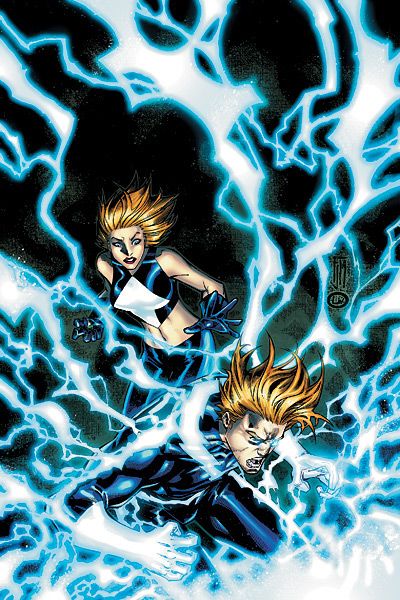Over the past 16 months, I've read every published "Legion of Super-Heroes" story in preparation for a book I just finished working on. None of that preparation is necessary for reviewing "Legion of Super-Heroes" #40, but it gives me a sense of context for this issue. I don't think you need any prior knowledge of the Legion to issue #40, but I also don't think this issue has much that would make you want to come back for more. It's not a terrible comic, by any means, but it's a good example of what's wrong with Shooter's attempt at writing the Legion, and it's a good example of why the series has so much potential.
It's a mixed bag, in other words, and depending on your tolerance for faux-futuristic curse words and overblown superhero melodrama, you might dislike this comic more than I do.
Francis Manapul's penciling is perfectly suited for this story, but it doesn't make or break the comic on its own. No, it's Shooter's story and dialogue that make this comic what it is, for better or worse, and this issue jumps all over the map, literally and figuratively, as the setting leaps from location to location and the characters alternate between moments of reasoned calm and spastic fury. It's a different kind of storytelling than Shooter employed on the Silver Age Legion, during the Adventure Comics era. Back then, his characters struggled nobly against outside forces, while here they seem to be bickering like a 1980s X-Men team. Perhaps Curt Swan's artwork added a tranquil stillness to the team in the Adventure stories, while Manapul's characters grit their teeth, contort their faces, and scowl expressively, and that's the big difference. But I don't think so. I think Shooter is making an effort to liven these characters up after a relatively stoic run by Mark Waid and Barry Kitson (and later, Tony Bedard and Dennis Calero).
While the Waid and Kitson run was about concepts like the generation gap, rebellion, and community, Shooter seems to want to shift the emphasis of the series away from social issues and toward characterization. Characterization the old-fashioned way: through conflict (within and without).
The problem with the characterization is that it's inconsistent with the previous issues. Brainiac 5, the outwardly calm and controlled (if arrogant) mastermind, is portrayed by Shooter as a hyperactive child. That might make for more interesting dynamics within the team (and perhaps too many characters from Waid and Kitson's Legion were outwardly calm and controlled), but it seems as if Shooter's just abruptly reinventing the characters as he sees fit, and that doesn't make much sense three dozen issues into a series. His treatment of Brainiac 5 is the most obvious example, but to be honest, few of the characters remain unchanged by Shooter.
All of that would seem to indicate that I don't like what Shooter's doing, and that's not exactly true. I'm annoyed at his flippant disregard for recently established characterization, but the comic has been given new life since he's come on board. Even this issue, which is mostly set-up for some future catastrophe, moves along nicely, and the jumps from location to location speed up the narrative momentum and keep a lot of characters involved in the story.
Shooter's "Legion" has the potential to become something special: a straight-ahead superhero action book, with compelling characters. It's a classic formula, and it has been proven to work in the past. Shooter just hasn't quite pulled it off here. Not yet.

